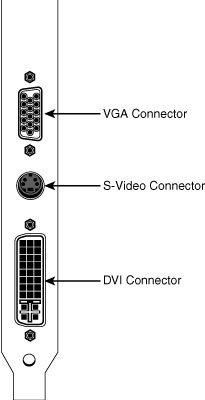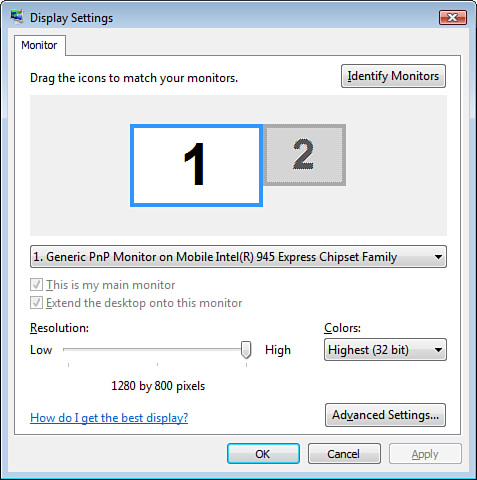Chapter 12. Upgrading to a Faster Video Card
Upgrading certain internal system components can increase the speed of your PC. We’ve already discussed how to upgrade memory (Chapter 10, “Adding More Memory”) and hard disk capacity (Chapter 11“Adding More Disk Space”); now it’s time to turn to your system’s video performance.
Like upgrading memory, installing a new video card is relatively easy—assuming that you’re comfortable opening up your desktop’s system unit, that is. And, if you’re trying to run graphics-intensive applications, this simple upgrade can make your system look and feel a lot faster than you’re used to.
The images you see on your computer monitor are generated inside the computer, via a specialized video card or chip on your motherboard (sometimes called a video adapter, graphics adapter, or display adapter). This card generates video images at a specified resolution, which is a measurement of how detailed your picture is. (The higher the resolution, the sharper the picture—and the more items you can fit onscreen.)
What benefit might you get from upgrading your computer’s video card? Many of today’s state-of-the-art applications require a fast video card with lots of onboard video memory to generate the rapidly changing three-dimensional graphics associated with the applications, and of Windows Vista itself. It takes a lot of horsepower to make all those objects appear to move around realistically onscreen in real time.
What applications are most difficult to display? Here’s a short list:
![]() Graphics-intensive PC games, especially those games with highly realistic 3D images
Graphics-intensive PC games, especially those games with highly realistic 3D images
![]() Video-editing programs, such as Adobe Premiere and Pinnacle Studio
Video-editing programs, such as Adobe Premiere and Pinnacle Studio
![]() Windows Vista’s Aero interface
Windows Vista’s Aero interface
Tip
Programs are graphics intensive when they have to create new three-dimensional graphics and video effects. Programs that merely reproduce existing graphics—such as displaying digital photographs or playing DVD movies—do not require near as much graphics horsepower, and will benefit less from a video card upgrade.
If your video card isn’t up to snuff, you might find any of these apps—or the Windows Aero interface—not displaying properly onscreen. The graphics might lack translucency or 3D effects; objects might not move smoothly across the screen; it’s possible that the entire interface might freeze up or not run at all. However it manifests itself, insufficient graphics power can noticeably slow down your PC.
Here’s why. Many low-end PCs come with (surprise!) low-performance video cards (or low-end video capability built right in to the motherboard), which just aren’t capable of displaying high-resolution graphics, fast-moving game images, and moving video from DVDs and digital movies. In fact, some PCs don’t even have dedicated video cards, instead relying on a motherboard-based graphics chip to do the job—or not, as the case may be.
So if your video display has a tendency to shudder and jerk, if it can’t run some of the latest graphics-intensive games, or if it can’t display all of Windows Vista’s fancy Aero graphics without getting bogged down, it’s time to think about getting a higher-performance video card.
Caution
Before you buy a new video card, make sure that you can actually upgrade your system’s video. Some low-end PCs come with the video adapter integrated into the motherboard—which means there’s no video card to change out. Fortunately, most systems with onboard video still let you add a separate video card, which then disables the built-in video capabilities. (You may have to enter your PC’s CMOS BIOS setup to disable the onboard video.)
Fortunately, upgrading your video card is pretty much as easy as removing the old one and replacing it with a new one. You do, however, want to pay attention to some key specifications when you’re shopping for a new card.
Note
The following specs are useful for the average home or business user. However, if you’re a really hardcore PC gamer or a graphics professional, there are even more video specifications that you need to look at—much more technical than I can go into here.
Your video card generates images at a specific resolution, typically measured in terms of pixels. While higher resolution is generally better, especially if you have a larger (19-inch or bigger) monitor, make sure the resolution of your card matches the resolution of your monitor. If a video card generates a higher resolution than your monitor is capable of, all you may see onscreen is gibberish.
All video cards contain some amount of video RAM (VRAM), which supplements your system’s main memory and is used to temporarily store graphics information while images are being assembled for display. The more memory on your video card, the faster high-resolution images (moving images, in particular) can be displayed.
How much memory is enough? For casual computing and gaming, I recommend at least 256MB of video RAM. For more serious PC gaming and speedy rendering of 3D graphics, you need a minimum of 512MB video RAM. Obviously, more VRAM is better; you should buy a card with as much onboard memory as you can afford.
A graphics accelerator is a special chip on the video card that assumes the task of drawing shapes onscreen. This enables faster rendering of graphics objects. A graphics accelerator specifically designed to render 3D graphics is sometimes called a 3D accelerator. If you’re an avid gamer, you need a card with a 3D accelerator to handle the graphics demands of today’s graphics-intensive games.
You can tell a 3D video card by looking at the card’s frame rate spec, which measures the number of frames per second of 3D animation that the card can reproduce. Cards with 3D accelerator chips have faster frame rates than other types of video cards.
DirectX is an evolving standard that defines a variety of application programming interfaces (APIs) for handling video rendering. To run Windows Vista Aero, your video card must support the DirectX 9 graphics standard. To play most of today’s graphics-intensive games, your video card should support the more advanced DirectX 10 (or later) standard.
Different types of computer monitors use different types of connectors. All CRT monitors and some LCD monitors use a traditional analog video (VGA) connector. Some LCD monitors use a digital (DVI) connector. Most video cards include a VGA connector; some include both VGA and DVI connectors.
In addition, some video cards include additional connections for connecting your PC to TV sets and home theater systems. These can include a single composite video jack, a higher-resolution S-video jack, or even higher-resolution three-cable component video connectors. If you’re using your computer to connect only to a standard computer monitor, you can ignore these connections and focus on the VGA and VCI connections. (Figure 12.1 shows a video card with the three most common types of connectors: VGA, DVI, and S-video.)
If you have the choice, go with a DVI connection—even though a DVI cable will cost substantially more than a comparable VGA cable. (Assuming that your monitor has a DVI connection, of course; not all do.) This digital connection is slightly faster than the older analog VGA connection, and provides higher resolution, at least in theory.
A desktop PC can have three different types of expansion card slots inside the system unit, as shown in Figure 12.2:
![]() PCI (Peripheral Component Interconnect), an older and slower standard. PCI lets your video card transfer data at a maximum rate of 133MBps.
PCI (Peripheral Component Interconnect), an older and slower standard. PCI lets your video card transfer data at a maximum rate of 133MBps.
![]() AGP (Accelerated Graphics Port), a newer and faster standard that is being phased out in favor of the even newer PCI Express. AGP lets your video card transfer data at up to 2.12GBps.
AGP (Accelerated Graphics Port), a newer and faster standard that is being phased out in favor of the even newer PCI Express. AGP lets your video card transfer data at up to 2.12GBps.
![]() PCI Express (also called PCIe), the newest expansion card standard. The PCIe 1.1 standard can transfer data up to 8GBps, and the newer PCIe2.0 standard doubles that maximum transfer rate to 16GBps.
PCI Express (also called PCIe), the newest expansion card standard. The PCIe 1.1 standard can transfer data up to 8GBps, and the newer PCIe2.0 standard doubles that maximum transfer rate to 16GBps.
Most newer computers use PCI Express, whereas computers more than three years old or so are likely to include both PCI and AGP slots. Today’s fastest video cards are PCIe cards. If you have an older computer without a PCIe slot, go with an AGP card instead.
Tip
If you’re a hardcore gamer, your choice of video card is simple: Go with any card that uses an nVidia chipset. nVidia makes the highest-performing video chips out there, and many game designers optimize their software to work best with the nVidia chipset. To learn more about nVidia chips—and which cards use them—check out the nVidia website, at www.nvidia.com.
When you’re shopping for a new high-performance video card, look for models from the following companies:
![]() ASUSTeK (www.asus.com)
ASUSTeK (www.asus.com)
![]() ATI by AMD (ati.amd.com)
ATI by AMD (ati.amd.com)
![]() BFG Technologies (www.bfgtech.com)
BFG Technologies (www.bfgtech.com)
![]() PNY Technologies (www.pny.com)
PNY Technologies (www.pny.com)
![]() XFX (www.xfxforce.com)
XFX (www.xfxforce.com)
Upgrading your video isn’t that hard to do. Yes, it’s a little technical, in that you have to open up your system unit to do it. But beyond that, it’s really just a matter of swapping out your old card for a newer one. Pull one out, push one in; that’s all there is to it. The technical part comes after you’ve installed the card—you have to tell Windows that you’re changing cards and then reconfigure your system to get the most out of your new card.
Caution
Static electricity can zap critical components when you’re working inside the system unit. Use an anti-static wrist strap or similar device to protect against static discharge before touching the video card or other internal components.
How do you upgrade your system’s video card? Follow these steps:
1. From within Windows, click the Start button and click Control Panel.
2. When the Control Panel opens in Windows XP, click System. In Windows Vista, click System, and when the next window opens, click Advanced System Settings.
3. When the System Properties dialog box appears, select the Hardware tab and click the Device Manager button.
4. When the Device Manager opens, click the Display Adapters item, select your video card, and click the Uninstall button (or select Action, Uninstall).
5. Close Windows and power off your system.
6. Power off your monitor.
7. Disconnect both your PC and your monitor from their power sources.
8. Open your PC’s system unit case, per the manufacturer instructions.
9. Locate your existing video card; it should have a cable running from the part that sticks out the rear of your system unit to your computer monitor, as shown in Figure 12.3. Disconnect this cable.
10. Remove the screw on the back of the system unit holding the old video card in place. Save the screw—you’ll need to use it again.
11. If there are any cables running to the video card from other devices inside the system unit (such as your sound card or DVD drive), label them with masking tape or a sticker, and then disconnect them form the video card.
12. Remove the old video card from its slot and set it aside.
13. Insert the new video card into the now-open slot.
14. Reconnect any cables you disconnected previously (in step 11).
15. Use the screw you saved in step 10 to fasten the new card into place.
16. Reattach the cable that connects your monitor to the new video card.
17. Reinstall the system unit cover and reconnect the PC to its power source; while you’re at it, go ahead and plug your monitor back in, too.
18. Power on your monitor, and then restart your computer.
19. Run the installation software that came with your new video card, or use the Windows Add Hardware Wizard to install the proper drivers for the new card.
That’s it—as far as the basic installation goes. You now have to reconfigure Windows to use the full capabilities of your new video card.
You configure your video card from within Windows, by following these steps:
1. Click the Start menu and select Control Panel.
2. When the Control Panel opens in Windows XP, click Display. In Windows Vista, click Personalize, and when the next window opens, click Display Settings.
3. When the Display Settings or Display Properties dialog box appears, as shown in Figure 12.4, use the Screen Resolution or Resolution slider to select the desired resolution. Use the highest resolution that your monitor can display.
Tip
Assuming that you’re running Windows on a 15-inch or bigger monitor, I recommend choosing a resolution of at least 1024×768.
4. Pull down the Color Quality or Colors list to select the desired color level. You should be able to use the highest 32-bit level.
5. Click OK to apply the new settings.
That’s it. Your new video card is now installed and configured. You should see an immediate improvement in video display performance.
If your PC is slowing down when displaying graphics-intensive applications, you can speed it up by upgrading to a more powerful video card. Here’s the bottom line:
![]() Rapidly-moving and three-dimensional graphics require significant graphics horsepower to create onscreen.
Rapidly-moving and three-dimensional graphics require significant graphics horsepower to create onscreen.
![]() A new graphics card with at least 512MB of onboard video RAM can speed up your system’s onscreen display.
A new graphics card with at least 512MB of onboard video RAM can speed up your system’s onscreen display.
![]() When shopping for a new video card, look for a PCI Express 2.0 card with DVI connection.
When shopping for a new video card, look for a PCI Express 2.0 card with DVI connection.
![]() To upgrade your video card, you must first remove your old card and then replace it with the new one.
To upgrade your video card, you must first remove your old card and then replace it with the new one.
![]() To configure Windows for the new card, use the Display Settings (Windows Vista) or Display Properties (Windows XP) dialog box; dial in the highest resolution and color quality your card and monitor support.
To configure Windows for the new card, use the Display Settings (Windows Vista) or Display Properties (Windows XP) dialog box; dial in the highest resolution and color quality your card and monitor support.




